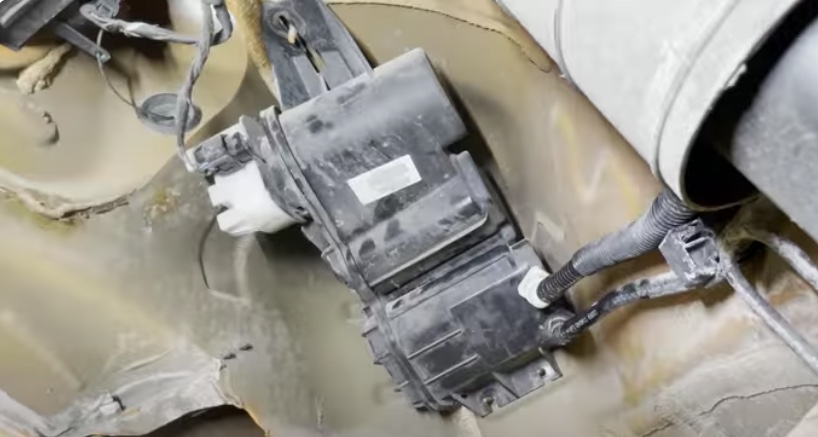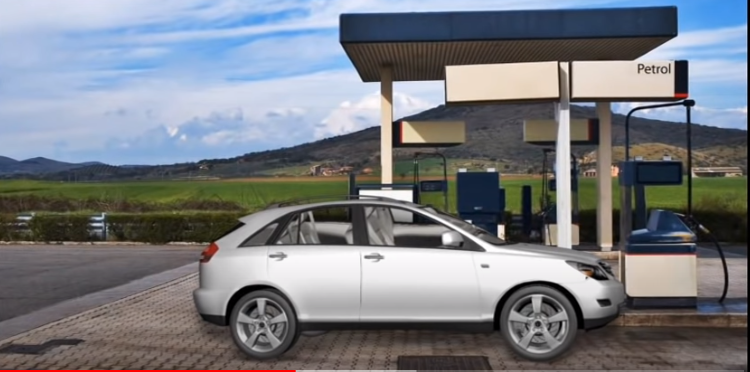2. Understanding On-Board Refueling Recovery
(ORVR)
Understanding On-Board Refueling Recovery
Explanation: Okay, so you know when we fill up our cars with gasoline at a gas station, sometimes you can smell a strong gasoline odor in the air? Well, that's not very good for the environment, and it's also wasteful because it's like money floating away into the air. That's where On-Board Refueling Vapor Recovery, or ORVR for short, comes into play.
Imagine your car has a super special nose (kind of like a vacuum power unit). This special nose can sniff out any smelly gasoline vapors that might try to escape when you're refueling your car. When you put the gas nozzle into your car's gas tank and start filling it up, some of the gas turns into tiny, invisible vapors that try to sneak away and make the air stink.
But with ORVR, your car's special nose goes to work. It captures those sneaky gasoline vapors and makes sure they go back into your car's gas tank where they belong. That way, no smelly gasoline escapes into the air, and you don't waste any money on lost gas.
Understanding On-Board Refueling Recovery:
Purpose: The purpose of On-Board Refueling Vapor Recovery (ORVR) is to keep the air cleaner and stop gasoline vapors from escaping into the environment when we fill up our cars with gas. It's like a vapor vacuum unit for our cars that helps protect the planet and saves us money by preventing those stinky vapors from getting away. So, ORVR is like a friendly superhero that works quietly every time we get gas, making sure we take care of the Earth and our wallets at the same time!

Understanding On-Board Refueling Recovery
Even though the EVAP system was performing its function well, it had no capability to control the hydrocarbons escaping during refueling. Starting in 1998 vehicles were required to have an OnBoard Refueling and Vapor Recovery (ORVR). The ORVR system was created to trap the hydrocarbons released during refueling. An ORVR system was designed to control vapors created during refueling by routing them to the canister during fuel refill.
Understanding On-Board Refueling Recovery:
Before 1998, cars had a system called EVAP, which worked fine but couldn't stop gases from escaping when you filled up with gas. Then, in 1998, they made a new system called On-Board Refueling Vapor Recovery, ORVR for short. ORVR's job is to catch the gases that escape when you put gas in your car. It's like a special trap for those gases. When you fill up your tank, ORVR makes sure those gases go into a special canister instead of floating away. This helps keep the air cleaner.
SUMMARIZE
- Before 1998, cars had a system called EVAP.
- EVAP couldn't stop gases from escaping during refueling.
- In 1998, they made a new system called ORVR.
- ORVR's job is to catch escaping gases during refueling.
- It traps these gases in a special canister.
- This helps keep the air cleaner by preventing gas fumes from floating away.
- EVAP system couldn't control escaping hydrocarbons during refueling.Starting in 1998, vehicles needed On-Board Refueling Vapor Recovery (ORVR).ORVR traps hydrocarbons released during refueling.It routes these vapors to a canister during fuel refill.
Have A Great Story About This Topic?
Have you ever had a problem with ORVR Systems, please Share your experience. If not explain something you learned about ORVR operation from this page.
What Other Visitors Have Said
Click below to see contributions from other visitors to this page...
Henry Honarchian tech/inspector 




It’s terrible cars before 1998 allowed fuel vapors to escape into the atmosphere while refueling.?
Tech Not rated yet
On board refueling vapor recovery ORVR . Is used to prevent fumes to escape the atmosphere as we do fuel refill , its main components are fuel filler …
Understanding On-Board Refueling Recovery
Fuel Filler Neck
- A fuel filler neck is like a tube in your car where you put gas when you visit a gas station.
- It's like a special tunnel that leads to your gas tank.
Purpose:
- The purpose of the fuel filler neck is to let you fill your car's gas tank easily and safely.
- You put the gas nozzle into this tube, and it sends the gas directly to your tank.
- It's important because it helps prevent spills and keeps you safe while refueling.
Understanding On-Board Refueling Recovery

Fuel Shut Off Valve
Purpose of a Fuel Shut-Off Valve:
The fuel cut valve (anti-spit back) valve prevents fuel from splashing back up the filler neck.
A defective valve can cause a hard start when refueling
SUMMARIZE
- Purpose: The fuel cut valve (anti-spit back) valve prevents fuel from splashing back up the filler neck.
- A defective valve can cause a hard start when refueling
Fill Vent Valve on a ORVR System
Operation of the Fill Vent Valve in an ORVR System:
The Fill Vent Valve in an ORVR system is like a helper for your car's gas tank when you're filling it up with gasoline. It has two important jobs:
- Fill Vent Valve: When you're putting gas into your car, air needs to come out of the gas tank to make room for the fuel. The Fill Vent Valve helps control the flow of vapors during refueling.
- Fuel Tank: When the tank is full, the valve is closed to prevent liquid fuel from going through the valve.
Purpose of the Fill Vent Valve:
The Fill Vent Valve helps control the flow of vapors during refueling.
Summary with Bullets:
- Operation: Fill Vent Valve helps vent air from the gas tank during refueling.
- Prevents Spills: Ensures smooth filling of the tank without spills.
- Safety: Acts as a safety feature, closing in case of issues to prevent gas leaks.
- The Fill Vent Valve helps control the flow of vapors during refueling.
Understanding On-Board Refueling Recovery
Fuel Rollover Valve
The main job of the fuel rollover valve is to stop gasoline from spilling out of the gas tank and going into the charcoal canister when the car is parked on a steep hill.
Fuel Liquid / Vapor Separator
Purpose of the Fuel Liquid/Vapor Separator:
The fuel liquid/vapor separator is like a sorting machine for gasoline in your car. Its job is to separate the liquid gasoline from the gasoline vapors. This helps keep the engine running smoothly and prevents gas fumes from escaping into the air.
Operation of the Fuel Liquid/Vapor Separator:
- Separating Liquid Gas: When you fill up your gas tank, the liquid gasoline goes into the fuel liquid/vapor separator.
- Keeping Vapors In: The separator makes sure that gasoline vapors (the smelly gas) stay inside and don't get into the engine.
- Sending Liquid Gas to the Engine: The liquid gas goes to the engine where it's used to make the car go.
- Trapping Vapors: Any gasoline vapors that are left are captured and sent back to the gas tank, so they don't pollute the air.
- The liquid vapor separator prevents liquid fuel droplets from reaching the vapor canister
Summary
- Purpose: Separates liquid gasoline from gasoline vapors.
- Operation:Takes liquid gas for the engine.Keeps gas fumes inside.Captures leftover vapors and sends them back to the gas tank.Helps the engine run smoothly and prevents air pollution.
- The liquid-vapor separator stops liquid fuel drops from going into the vapor canister.
Understanding On-Board Refueling Recovery
Two Way Valve / Pressure Vacuum Relief Valve
How the Two-Way Valve for Pressure Vacuum Relief Works in an On-Board Refueling System:
The Two-Way Valve for Pressure Vacuum Relief is like a gatekeeper for your car's gas tank. It has an important job to do:
- Pressure Relief: When the gas tank gets too much pressure, like on a hot day, the valve can open to let some air out. This helps keep the tank from bursting or leaking.
- Vacuum Relief: On a very cold day or when you use up a lot of gas, the tank can create a vacuum, which means it sucks air in. The valve can also open to let some air in to balance things out.
- Stopping Gas Fumes: The valve is clever because it also stops gasoline fumes from escaping into the air, which helps keep the environment clean.
Have A Great Story About This Topic?
Have you ever had a problem with a Honda or Toyota Two Way Valve / Pressure Vacuum Relief Valve please Share your experience? If not explain something you learned about the Two Way Valve / Pressure Vacuum Relief Valve you read on this page.
What Other Visitors Have Said
Click below to see contributions from other visitors to this page...
Sergio Alvarado Technician Not rated yet
this system works as the following way or as I understand it Pressure Relief. When the gas tank gets too much pressure, like on a hot day, the valve can …
SUMMARIZE
- Purpose:Keeps the gas tank from getting too pressurized or creating a vacuum.Prevents gas fumes from escaping.
- Operation:Opens when there's too much pressure or vacuum in the tank.Balances the air inside the tank.Protects the tank and the environment.
- The valve works as a pressure relief valve when the system pressure becomes too high, and it also serves as a directional valve, letting fresh air enter the charcoal canister.
Purpose of the Charcoal Canister
The charcoal canister is like a big sponge inside your car. Its main job is to clean the air that comes out of the gas tank. Here's how it works:
- When you put gas in your car, some smelly gasoline fumes can escape from the tank.
- The charcoal canister grabs those smelly fumes and holds onto them.
- It prevents these fumes from going into the air, which keeps the environment cleaner.
- Later, when the engine is running, it uses those captured fumes to make the engine work better and not let any harmful gases escape.
Summary
- Cleans smelly gasoline fumes from the gas tank.
- Keeps the air cleaner by stopping gas fumes from escaping.
- Helps the engine work better by using the captured fumes.
Vapor Valve
The vapor valve connects to a canister through the ORVR valve. This valve has a float inside that stops the vent when the gas tank is full. If the ORVR valve is not working properly, it can lead to leaks or make it hard to fill the tank because it closes the filler nozzle too soon when pressure builds up.
SMOG UPDATE ONLINE CLASS Power Point Presentation
CLICK HERE FOR ACCESS
What is the EVAP System
CLASS SCHEDULES
Emission Control 1:
B.A.R. Smog Check
Inspector Level 1
(Inspector "Smog" License):
Engine Fundamentals
8am - 12:15 pm
Summer Class
7/5/2022 -8/5/2022
Class # 799065
Emission Control 2:
B.A.R. Smog Check
Inspector Level 2
(Inspector "Smog" License):
Rules and Regulations
8am - 12:15 pm
Summer Classes
7/5/2022 - 8/5/2022
Class # 799067
Engine Performance 1:
8am - 12: 15 pm
Date: TBD
Class # 799069
Engine Performance 2:
B.A.R. Specified Diagnostic
and Repair Training
(Repair "Smog" License)
Time: TBD
Date: TBD
Class # 799071
Emission Control 1
(Inspector "Smog" License):
5:00pm - 8:45 pm
Date: TBD
Class # 799065
Emission Control 2:
(Inspector "Smog" License):
5:00pm - 8:45 pm
Date: TBD
Class # 799065
Exhaust Emissions (Update Class):
5:30 pm - 8:45 pm
Tuesday nights:
Dates: coming soon
Class # 796070